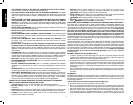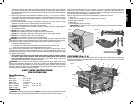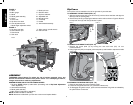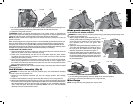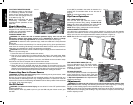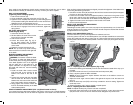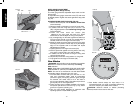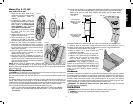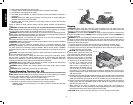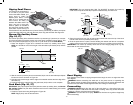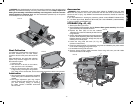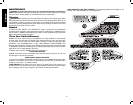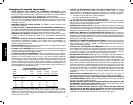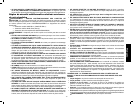
12
English
3. Bevel angle and height lock knobs are tight.
4. If ripping, ensure fence lock lever is tight and fence is parallel to the blade.
5. If crosscutting, miter gauge knob is tight.
6. The blade guard assembly is properly attached and the anti-kickback assembly is
functioning.
7. ALWAYS inspect the blade guard assembly and riving knife for proper alignment,
operation and clearance with saw blade.
8. ALWAYS make sure both guards are in the down position in contact with the table
before operating.
Failure to adhere to these common safety rules can greatly increase the likelihood of
injury.
WARNING: To reduce the risk of injury, turn unit off and disconnect machine from
power source before installing and removing accessories, before adjusting or changing
set-ups or when making repairs. An accidental start-up can cause injury.
WARNING: Before connecting the table saw to the power source or operating the saw,
always inspect the blade guard assembly and riving knife for proper operation alignment
and clearance with saw blade. Personal injury may result.
WARNING: Ripping or crosscutting may cause saw to tip over while operating. Make
sure saw is securely mounted to a stable surface.
WARNING: Never use the fence and miter gauge together. This may cause a kickback
condition and injure the operator.
CAUTION: If your saw makes an unfamiliar noise or if it vibrates excessively, cease
operating immediately, turn unit off and disconnect from power source until the problem
has been located and corrected. Contact a D
EWALT factory service center, a DEWALT
authorized service center or other qualified service personnel if the problem can not be
found.
CAUTION: The proper throat plate must be in place at all times to reduce the risk of a
thrown work piece and possible injury.
There are two basic types of cutting with table saws: ripping and crosscutting. Cutting
with the grain is ripping and cutting against the grain is crosscutting. With manmade
materials, the distinction is made such that ripping is cutting to a different width and
crosscutting describes cutting material across the shorter dimension.
WARNING: When ripping, always use the fence to provide a guide for the material and
blade guard assembly against a kickback situation.
WARNING: Never perform any cutting operation free hand. Never perform plunge
cutting.
CAUTION: When crosscutting, always use the miter gauge.
Guard Operating Feature (Fig. 32)
WARNING: To reduce the risk of injury, turn unit off and disconnect machine from
power source before installing and removing accessories, before adjusting or changing
set-ups or when making repairs. An accidental start-up can cause injury.
1. The guard(s) will lock in place when in the raised position.
2. This feature increases visability when measuring the blade to fence distance.
3. Push down on guard(s) and they will release to the operating position.
• ALWAYS make sure both guards are in the down position in contact with the table
before operating.
FIG. 32
RAISED
POSITION
OPERATING
POSITION
Ripping
WARNING: Never touch the “free end” of the work piece or a “free piece” that is cut
off, while the power is ON and/or the saw blade is rotating. Piece may contact the blade
resulting in a thrown work piece and possible injury.
WARNING: A rip fence should ALWAYS be used for ripping operations to prevent loss
of control and personal injury. NEVER perform a ripping operation freehand. ALWAYS lock
the fence to the rail.
WARNING: When bevel ripping and whenever possible, place the fence on the side of
the blade so that the blade is tilted away from the fence and hands. Keep hands clear of
the blade and use a push stick to feed the work piece if there is less than 6" (152 mm)
between the fence and the blade.
1. Lock the rip fence by pressing the rail lock lever down. Remove the miter gauge.
2. Raise the blade so it is about 1/8" (3.2 mm) higher than the top of the work piece.
3. Hold the work piece flat on the table and against the fence. Keep the work piece about
1" (25.4 mm) away from the blade.
CAUTION: The work piece must have
FIG. 33
a straight edge against the fence and
must not be warped, twisted or bowed.
Keep both hands away from the blade
and away from the path of the blade.
See proper hand position in Figure 33.
4. Turn the saw on and allow the blade
to come up to speed. Both hands
can be used in starting the cut.
When there is approximately 12"
(305 mm) left to be ripped, use only
one hand, with your thumb pushing
the material, your index and second finger holding the material down and your other
fingers hooked over the fence. Always keep your thumb along side your first two fingers
and near the fence.
5. Keeping the work piece against the table and fence, slowly feed the work piece rearward
all the way through the saw blade. Continue pushing the work piece until it is clear of the
blade guard assembly and it falls off the rear of the table. Do not overload the motor.
6. Never try to pull the work piece back with the blade turning. Turn the switch off, allow the
blade to stop, raise the anti-kickback teeth on each side of the riving knife if necessary
and slide the work piece out.
7. When sawing a long piece of material or a panel, always use a work support. A
sawhorse, rollers, or out feed assembly provides adequate support for this purpose. The
work support must be at the same height as the saw table.
CAUTION: Never push or hold onto the “free” or “cut off” side of the work piece.



